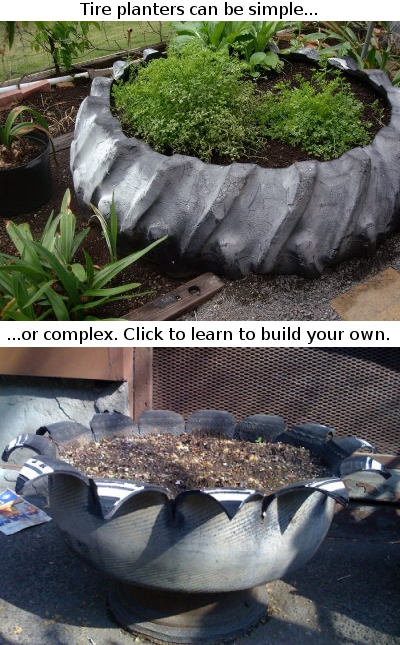
African-American Gardens and Yards in the Rural South
 When
I was a youngster, our nearest neighbor's front yard was decked out
with a
huge tire, painted white and filled with flowers. A metal glider
and chairs, also painted white, stood nearby under the shade of a large
catalpa, just waiting for a visitor to come by and sit for a
spell. There were flowers --- nearly all annuals that were easy
to grow from seed, like marigolds and cockscomb --- and a blooming
bush. Across the yard was a pen of chickens, then the barn, and
in the other direction was the vegetable garden, laid out in straight
rows. The couple clearly spent considerable time, though little
money, keeping their yard in impeccable shape.
When
I was a youngster, our nearest neighbor's front yard was decked out
with a
huge tire, painted white and filled with flowers. A metal glider
and chairs, also painted white, stood nearby under the shade of a large
catalpa, just waiting for a visitor to come by and sit for a
spell. There were flowers --- nearly all annuals that were easy
to grow from seed, like marigolds and cockscomb --- and a blooming
bush. Across the yard was a pen of chickens, then the barn, and
in the other direction was the vegetable garden, laid out in straight
rows. The couple clearly spent considerable time, though little
money, keeping their yard in impeccable shape.
Although my neighbors
were white, their space could have graced the pages of Richard
Westmacott's African-American
Gardens and Yards in the Rural South,
with the notable lack of a hog butchering station and a swept dirt
floor. Westmacott analyzed the yards of 47 rural families
spread across
Alabama, Georgia, and South Carolina, focusing on folks who had reached
or passed middle age. If there was such a thing as a traditional
Southern, African-American garden, he wanted to find it.
 And he did see similarities,
many noted in my opening paragraph.
Rather than being showcased landscapes, the yards were subsistence
gardens
where work and leisure intermingled. In most cases, the yard had
become an extension of the house, the spot for a family barbecue or hog
butchering session.
And he did see similarities,
many noted in my opening paragraph.
Rather than being showcased landscapes, the yards were subsistence
gardens
where work and leisure intermingled. In most cases, the yard had
become an extension of the house, the spot for a family barbecue or hog
butchering session.
But where did the
similarities come from? Could they be traced
back to the families' heritage in western Africa, to their slave
background, or were the similarities simply the common byproduct of
being poor
in the South?
| This post is part of our African-American Gardens and Yards in the
Rural South lunchtime series.
Read all of the entries: |
Want more in-depth information? Browse through our books.
Or explore more posts by date or by subject.
About us: Anna Hess and Mark Hamilton spent over a decade living self-sufficiently in the mountains of Virginia before moving north to start over from scratch in the foothills of Ohio. They've experimented with permaculture, no-till gardening, trailersteading, home-based microbusinesses and much more, writing about their adventures in both blogs and books.
Want to be notified when new comments are posted on this page? Click on the RSS button after you add a comment to subscribe to the comment feed, or simply check the box beside "email replies to me" while writing your comment.

I don't think I realized that was a ham curing shed --- makes their yard even more like the ones in the book!
I should also add that Mom pointed out that their planters were painted blue, not white. My memory obviously failed me.
I recommend it --- a fast read with lots of pictures!
Every year, I'm tempted to plant a catalpa, and every year I realize that I can't bear to take any space away from future fruit trees. I love them, though!
I love them, though!